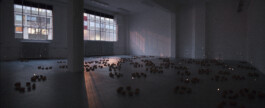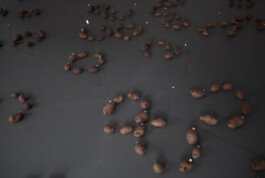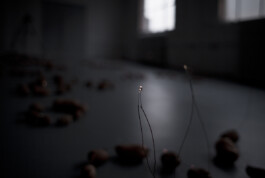Isolated Systems Vol.1, 2015
Potatoes, zinc, copper, LEDs
Dimensions variable

Esther Mathis’ Isolated Systems Vol.1 examines the aesthetic and cultural values of atmospherics through the creation of miniature ecosystems. In simplest terms, the exhibition realizes the basic living principle, both sensorial and mechanical, that when one connects or joins the right conduits in a positive way, something like light, or another kind of flow, can result.
Mathis has resurrected the childhood game of the potato lamp, a basic vegetable apparatus that is often displayed to illustrate to students the simple wonders of electricity. However, in Mathis’ hands, the quantity of these potatoes has reached nearly a thousand, with each individual zinc circuit soldered and assembled to an LED bulb by hand – a mundane but magical act that produces a singular beam of light.
Transporting the instruments from her atelier in Zurich to Geneva, Mathis has transformed the darkened exhibition space of Piano Nobile into a labyrinth of copper wire and liquid crystal, half-light. The aesthetic result is the production of a world inside a world.
“...there is room in this world for idyllic gardens,
for lyrical gardens, even for didactic gardens,
where, at every step, your mind seems to be improved,
even if your heart be not touched.”
(Alfred Austin, The Gardens that I Love, 1894)
Undergirding the sedate terrain is the perpetual dynamic of entropy, the will of the cosmos, doing and undoing, working and unworking, seeking equilibrium while nullifying itself. Part and parcel of Mathis’ installation is the attendant experience of lack...lack of space and light portrayed through its dimming contours. In order to illuminate its space to current visual standards, the exhibition room would most likely require more potatoes than it could hold, a disturbing parable of modernity’s ecological excess. As OuLiPo writer and urban phenomenologist Georges Perec notes in his essay collection, Species of Space, “Space is a doubt: I have constantly to mark it, to designate it. It’s never mine, never given to me, I have to conquer it.”
Over the course of many weeks, the potatoes will lose their conductivity, causing the light source to diminish, although such metered gradations will be nearly invisible to the human eye. The emissions of light will become pure heat. The potatoes will become waste. Always directed in the future tense – becoming – the isolated system’s miniature scale parallels our own mortal diminution.
And here on earth come emulating flies,
That though they never equal stars in size,
(And they were never really stars at heart)
Achieve at times a very star-like start.
Only, of course, they can’t sustain the part.
(Robert Frost, Fireflies in the Garden, 1928)
Like any fragile ecosystem, Isolated Systems inhabits states both processual and material, the intersections of which exist as the rather cryptic matrix we call atmosphere. The ultimate power of the exhibition resides in its capacity to represent a world inside a world and the microcosmic atmospheres fluctuating therein. In so doing, Mathis has created a playful experiment, a garden preserve and a bijou installation to be enjoyed for its simplicity of concept and complexity of vision.
Erik Morse, October 2015



Isolated Systems Vol.1, 2015
Potatoes, zinc, copper, LEDs
Dimensions variable
Esther Mathis’ Isolated Systems Vol.1 examines the aesthetic and cultural values of atmospherics through the creation of miniature ecosystems. In simplest terms, the exhibition realizes the basic living principle, both sensorial and mechanical, that when one connects or joins the right conduits in a positive way, something like light, or another kind of flow, can result.
Mathis has resurrected the childhood game of the potato lamp, a basic vegetable apparatus that is often displayed to illustrate to students the simple wonders of electricity. However, in Mathis’ hands, the quantity of these potatoes has reached nearly a thousand, with each individual zinc circuit soldered and assembled to an LED bulb by hand – a mundane but magical act that produces a singular beam of light.
Transporting the instruments from her atelier in Zurich to Geneva, Mathis has transformed the darkened exhibition space of Piano Nobile into a labyrinth of copper wire and liquid crystal, half-light. The aesthetic result is the production of a world inside a world.
“...there is room in this world for idyllic gardens,
for lyrical gardens, even for didactic gardens,
where, at every step, your mind seems to be improved,
even if your heart be not touched.”
(Alfred Austin, The Gardens that I Love, 1894)
Undergirding the sedate terrain is the perpetual dynamic of entropy, the will of the cosmos, doing and undoing, working and unworking, seeking equilibrium while nullifying itself. Part and parcel of Mathis’ installation is the attendant experience of lack...lack of space and light portrayed through its dimming contours. In order to illuminate its space to current visual standards, the exhibition room would most likely require more potatoes than it could hold, a disturbing parable of modernity’s ecological excess. As OuLiPo writer and urban phenomenologist Georges Perec notes in his essay collection, Species of Space, “Space is a doubt: I have constantly to mark it, to designate it. It’s never mine, never given to me, I have to conquer it.”
Over the course of many weeks, the potatoes will lose their conductivity, causing the light source to diminish, although such metered gradations will be nearly invisible to the human eye. The emissions of light will become pure heat. The potatoes will become waste. Always directed in the future tense – becoming – the isolated system’s miniature scale parallels our own mortal diminution.
And here on earth come emulating flies,
That though they never equal stars in size,
(And they were never really stars at heart)
Achieve at times a very star-like start.
Only, of course, they can’t sustain the part.
(Robert Frost, Fireflies in the Garden, 1928)
Like any fragile ecosystem, Isolated Systems inhabits states both processual and material, the intersections of which exist as the rather cryptic matrix we call atmosphere. The ultimate power of the exhibition resides in its capacity to represent a world inside a world and the microcosmic atmospheres fluctuating therein. In so doing, Mathis has created a playful experiment, a garden preserve and a bijou installation to be enjoyed for its simplicity of concept and complexity of vision.
Erik Morse, October 2015

